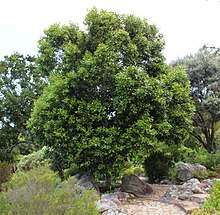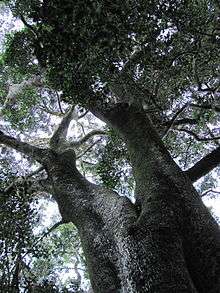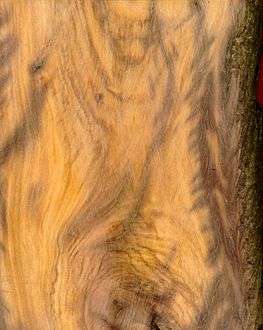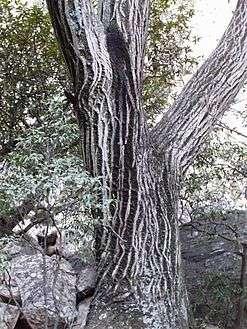Olea capensis
Olea capensis, also known by the common name black ironwood,[2] is an African tree species belonging to the Olive family (Oleaceae). It is widespread in Sub-Saharan Africa from the east in Somalia, Ethiopia and Sudan, south to the tip of South Africa, and west to Cameroon, Sierra Leone and the Islands of the Gulf of Guinea, as well as Madagascar and the Comoros.[1] It occurs in bush, littoral scrub and evergreen forest.[3]
| Black ironwood | |
|---|---|
 | |
| Scientific classification | |
| Kingdom: | Plantae |
| Clade: | Tracheophytes |
| Clade: | Angiosperms |
| Clade: | Eudicots |
| Clade: | Asterids |
| Order: | Lamiales |
| Family: | Oleaceae |
| Genus: | Olea |
| Species: | O. capensis |
| Binomial name | |
| Olea capensis | |
Other common names in English include ironwood, ironwood olive, East African olive and Elgon olive.[3]

Description
The black ironwood is a bushy shrub, or a small to medium-sized tree, up to 10 metres (33 ft) in height, occasionally reaching 40 metres (130 ft).[3]
- Bark: light grey, becoming dark grey and vertically fissured with age; a characteristic blackish gum is exuded from bark wounds.
- Leaves: light to dark green and glossy above and paler green below; petiole often purplish, 0.3–1.7 cm long; lanceolate-oblong to almost circular, 3–10 x 1.5–5 cm.
- Flowers: white or cream and sweetly scented, small and in many flowered axillary or terminal heads, bisexual, 3–15 cm long.
- Fruit: when ripe they are somewhat succulent purplish drupes; ovoid up to 2 x 1 cm.
Subspecies
The species has been divided into 3 subspecies:[3]
- Olea capensis macrocarpa: flowers in lax heads, fruits oblong to elliptic.
- Olea capensis capensis: flowers in dense heads, leaves very variable, apex often rounded, and fruits almost spherical to oblong elliptic.
- Olea capensis enervis: leaves usually broadly elliptic, apex tapering.
Uses
- Food
Olea capensis has masses of sweetly scented bisexual flowers, that produce large edible fruits.
- Lumber
The wood of the tree is very hard, fine grained, and heavy, and although difficult to work, it is widely used for art and artifacts.
- Gardens
Olea capensis is cultivated as an ornamental tree in parks and gardens.
The Guinness Book of World Records lists this tree as the world's heaviest wood, with a specific gravity of 1.49, similar to that of anthracite or dry earth.[4] It is known for its tendency to sink in water, unlike other wood materials. It is also the one of the world's hardest woods according to the Janka hardness test. The timber has a good abrasion resistance and is very strong. It is an excellent turnery wood, and is used for a wide range of decorative items.
Gallery
Olea capensis flowers 
Timber 
Leaves 
Trunk and bark
References
- "Olea capensis". World Checklist of Selected Plant Families (WCSP). Royal Botanic Gardens, Kew. Retrieved 4 August 2017.
- "Olea capensis". Germplasm Resources Information Network (GRIN). Agricultural Research Service (ARS), United States Department of Agriculture (USDA). Retrieved 4 August 2017.
- "Olea capensis" (PDF). World Agroforestry Centre. Retrieved 4 August 2017.
- https://www.engineeringtoolbox.com/specific-gravity-solids-metals-d_293.html
- "Olea capensis". Ecocrop FAO. Archived from the original on 2011-07-26. Retrieved 2010-02-09.
- "Olea capensis subsp. capensis". Aluka. Archived from the original on 2013-08-01. Retrieved 2010-02-09.
- "Olea capensis subsp. capensis". Fernkloof Nature Reserve. Archived from the original on 2011-07-16. Retrieved 2010-02-09.
| Wikimedia Commons has media related to Olea capensis. |